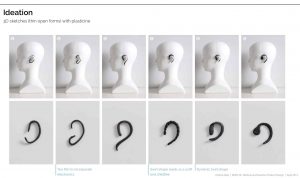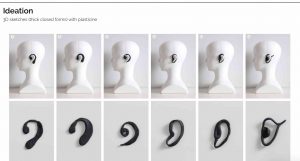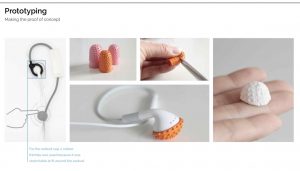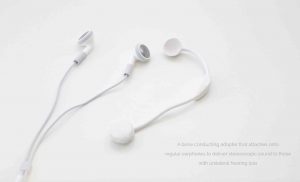Kristina Mok | April 2015
A bone conducting adapter that attaches onto regular earphones to deliver stereoscopic sound to those with unilateral hearing loss.
For my empathy study, I stepped into the shoes of someone who is partially deaf. To simulate partial deafness, I inserted an earplug in my left ear. I had my hair down so that it would cover it an d hide it from people, so it wouldn’t change the way people would act around me.
When I used the computer, the experience was a lot different then what I was used to. Something as simple as watching a video on youtube was uncomfortable because it felt like the sound was coming from a far away source. As such, I had to fully concentrate on the video.
I was on high alert at all times while walking down the street because the cars would sound like they were still a good distance away but would be zipping past me the next second. Since I was walking by a busy street, I had to constantly scan my environment to ensure my safety.
One of the thing that bothered me was how every step and every movement of my jacket as I swung my hand sounded really loudly in my ear. I’m not sure if this echo is actually experienced by people with partial deafness, but if it is, I would certainly not be used to it.
• Complete hearing loss in left ear
• Doesn’t wear hearing aid
• Can hear stereoscopic sound when music source is placed on the left side of her jaw (bone conduction)
• Developed unilateral sensorineural (nerve) hearing loss due to a side effect of a drug when she contracted meningitis at 4 years old
• Complete hearing loss in her left ear but still has full hearing in her right
• Doesn’t wear hearing aid or use any assistive communica- tion tools
• Little changes to positioning when listening to a speaker (e.g. walk on the left of the speaker)
• Can hear stereoscopic sound when a music source is placed on the left side of her jaw (bone conduction)

What is hearing loss?
Hearing loss, or deafness, is a general term that refers to the partial or complete loss of hearing in one or both ears.
There are many causes of deafness, some of which include genetics, contracting disease or virus, or exposure to loud noise. It can occur at any age and to anybody. It is a misconception that people who are deaf cannot hear at all. In fact, those with mild to moderate hearing loss are still able to hear sounds, albeit unclear and less intense than the original stimuli.
The majority of people with hearing loss can use assistive audio devices like hearing aids to amplify the surrounding sounds and voices. One factor for choosing the appropriate device would be determining the type of hearing loss.
Conductive hearing loss (mechanical)
• Effects ear canal, ear drum, or the 3 inner ear bones • Mechanical damage (e.g. ear drum or 3 inner ear bones don’t vibrate in response to sound)
• Bone conduction works better than air conduction
Sensorineural hearing loss (nerve)
• Effects cochlea, cochlear nerve, semicircular canals • Tiny hair cells (nerve endings that send signals to brain) are injured and do not work correctly
• Cannot be reversed in certain cases
Preliminary Research
Bone conduction
What is bone conduction?
Bone conduction is the transmittance of sound through vibrating bones.
This type of sound transmission works best for people who have conductive or unilateral hearing loss as one working cochlea is able to pick up on the resonating sound. Bone conducting devices act like an external ear drum and are the most effective when placed on the temple, jaw, and areas around the ear.
Preliminary Research
Bone conduction experiment with co-creator

Purpose: to conduct an experiment with my co-creator to locate the primary location(s) for bone conduction for audio transmission. Materials: earbuds and a music player
Experiment variables: volume, position of earbuds on the face, covering and not covering the right ear (the hearing side)
Concept 1 Feedback
Furniture That Listens: localized sound capturing in dining environments
Guest critics:
• Relevant design space as there is a large problem with hearing aids today picking up background sound in restaurant settings • How is the product marketed and to whom (restaurants, individual users, etc.)
Grace from Western Institute of the Deaf and Hard of Hearing:
(note: I presented to her my 3 concepts in my meeting with her this morning before presentation)
• Relevant problem space
• FM microphone can pick up vibrations coming from the table or chair (any hard surface that the microphone is attached to)
– Be aware of the location of embedded technology
• Elevate FM microphone away from the table
• Existing stand alone FM systems would work better than this concept because of less physical obstruction and hindrance with the table.
Concept 1 Feedback
Furniture That Listens: localized sound capturing in dining environments
Guest critics:
• Relevant design space as there is a large problem with hearing aids today picking up background sound in restaurant settings • How is the product marketed and to whom (restaurants, individual users, etc.)
Grace from Western Institute of the Deaf and Hard of Hearing:
(note: I presented to her my 3 concepts in my meeting with her this morning before presentation)
• Relevant problem space
• FM microphone can pick up vibrations coming from the table or chair (any hard surface that the microphone is attached to)
– Be aware of the location of embedded technology
• Elevate FM microphone away from the table
• Existing stand-alone





FM systems would work better than this concept because of less physical obstruction and hindrance with the table.
Concept 3 Feedback
Mental Stereo: Portable device that plugs into any audio port
Guest critics:
• No feedback on concept 3 (maybe unclear or not as interesting)
Grace (WIDHH):
• Similar technology is being developed by large companies like Oticon as there is an increasing demand for miniaturizing hearing aids and making it universal for multiple products.
• Bluetooth or 2.4 gHz technology would work best for this system
• An existing technology called the streamer does something similar to this. Although it’s bulky and worn around the neck, it picks up signals coming from different devices and uses bluetooth to relay the connected signal to the hearing aid.

Second Presentation Feedback
Feedback from guest critics
Laura:
• Helpful to show precedents to contextualize what exists right now and why I am pursuing this project. – What makes my product different from the existing ones.
Ian:
• There could be different ways of attaching the adapter. One suggestion was to attach to glasses as it gets away from the adapter from looking too much like a hearing aid. – Could attach to the ends of the glasses since there needs to be pressure applied for bone conduction to work
– Especially since my co-creator wears glasses, attaching it there would be relevant.
• Had a hard time understanding what bone conduction is.
Lucia:
• Material exploration
• Helpful to see earbud being used with prototype
